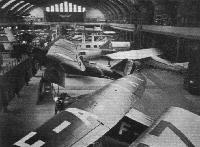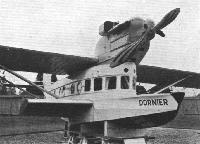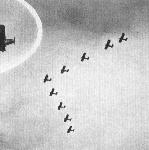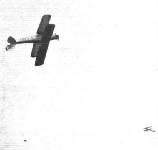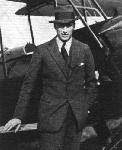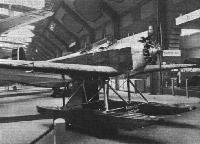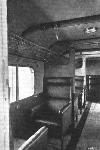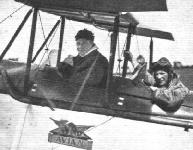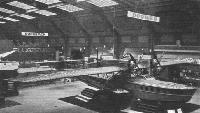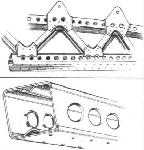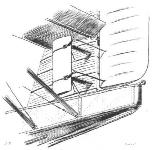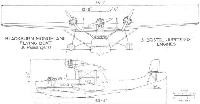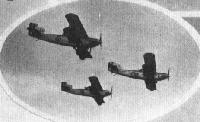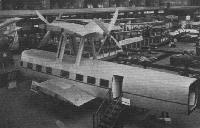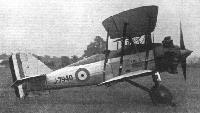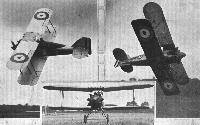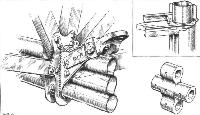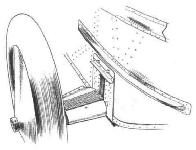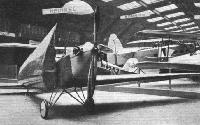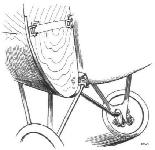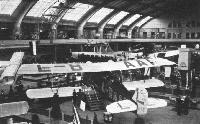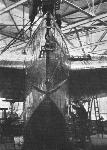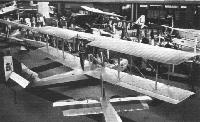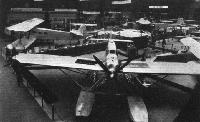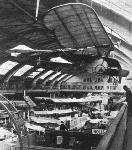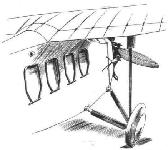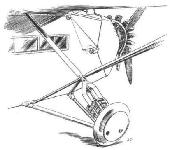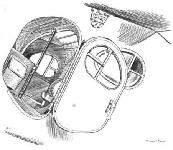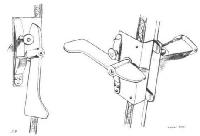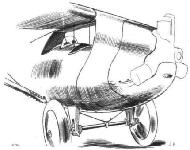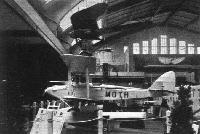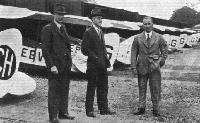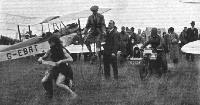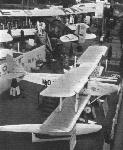Фотографии
-
Регистрационный номер: F-AIXI [2] On the French stand: In the foreground the Nieuport-Delage commercial monoplane. In the extreme corner, a wing tip of the Potez 32. In the centre, the old Breguet "Nungesser-Coli." To the right of that the small Farman monoplane. And at the back, the Bleriot 111 and the fuselage of the Farman twin-engined machine.
Самолёты на фотографии: Bleriot Bleriot-111 - Франция - 1929Breguet Br.19GR Grand Raid / Br.19TF Super Bidon - Франция - 1925Farman F.180 Oiseau Bleu - Франция - 1928Farman F.190 / F.390 - Франция - 1928Nieuport-Delage Ni-D-640 - Франция - 1927Potez Potez 32 / 33 - Франция - 1928
-
The Dornier "Dolphin": Developed from the "Komet" type of landplane, this machine has a central hull added to a normal fuselage, but with an unusual engine placing.
Самолёты на фотографии: Dornier Delphin - Германия - 1920
-
THE R.A.F. DISPLAY FOR A SULTAN: On October 11 the R.A.F. gave a Display at Hendon in honour of the Sultan of Muscat. Our illustration shows No. 29 Fighter Squadron at Drill.
Самолёты на фотографии: Armstrong Whitworth Siskin - Великобритания - 1921
-
THE R.A.F. DISPLAY FOR A SULTAN: On October 11 the R.A.F. gave a Display at Hendon in honour of the Sultan of Muscat. Our illustration shows another view of No. 29 Squadron.
Самолёты на фотографии: Armstrong Whitworth Siskin - Великобритания - 1921
-
A MECCANO "ARGOSY": The accompanying scale model of the Armstrong-Whitworth "Argosy" is built throughout with standard Meccano parts. It has a span of 65 in. and a length of 52 in.; each of the three engines is operated by its own electric motor run from a 4-volt accumulator. The "joy-stick" operates the ailerons and elevators, while a rudder bar actuates the rudders - true to life! We would draw Mr. Handley Page's attention to the new circular slots fitted to the wings - and other parts.
Самолёты на фотографии: Armstrong Whitworth Argosy - Великобритания - 1926
-
Регистрационный номер: G-EBOU "STAR TURN" AT NORTHAMPTON: Flying Officer R. L. R. Atcherley in a conventional position (for him) on his back in Flight-Lieut. Soden's "Genet-Moth" "OU" during a roll. He "shot up" the large crowd at Syweil on Saturday in his usual way, diving low and clearing with climbing rolls.
Самолёты на фотографии: De Havilland Moth / D.H.60 - Великобритания - 1925
-
Mr. N. St. V. Norman, private owner of a D.H. "Moth" (Cirrus) fitted with Handley Page slots. He is codirector with Mr. F. A. I. Muntz, of Airwork, Ltd., who are constructing the Heston Aerodrome, Middlesex.
Самолёты на фотографии: De Havilland Moth / D.H.60 - Великобритания - 1925
-
U.S. NATIONAL AIR RACES: The D.H. "Moth," flown by its owners, Kenneth E. Whyte and Harry R. Campbell (Members of the Hamilton, Ont., Aero Club), in the International Trans-Continental Air Race (Windsor - Los Angeles). They came in second.
Самолёты на фотографии: De Havilland Moth / D.H.60 - Великобритания - 1925
-
Bombing Event at Northampton: Capt. H. Broad diving to attack the elusive car with bombs (bags of flour) in the "Gipsy-Moth"; an interesting event in which many pilots tried their hand. The continuance of joyriding slightly interfered with movements. Capt. E. W. Percival, on his Avro "Avian," with which he gained second place at the French Light 'PlaneTrials, planted some excellent shots.
Самолёты на фотографии: De Havilland Moth / D.H.60 - Великобритания - 1925
-
U.S. National Air Races: A "Waco Ten," of which several were entered for the various events. It was one of these machines, piloted by W. H. E. Drury (a native of St. Catherines, Ont.), and fitted with a Wright "Whirlwind" that won the International Trans-Continental Race.
Самолёты на фотографии: WACO 10 / O Series - США - 1927
-
An Historic Exhibit. The Junkers W33 "Bremen," which made the first east to west Atlantic flight.
Самолёты на фотографии: Junkers W 33 / W 34 / Ju.46 - Германия - 1926
-
The Klemm L.25 W seaplane is a two-seater with 40 h.p. Salmson engine. This machine has taken off the water with three on board. The float undercarriage is interchangeable with the landplane unit.
Самолёты на фотографии: Klemm L.25 - L.28 Swallow - Германия - 1927
-
The Junkers G.31 has three "Jupiter" engines, of which the central engine is fitted with a four-bladed propeller. This engine is geared, while the wing engines are direct-drive types.
Самолёты на фотографии: Junkers G 31 - Германия - 1926
-
View inside the cabin of the Junkers G.31.
Самолёты на фотографии: Junkers G 31 - Германия - 1926
-
U.S. NATIONAL AIR RACES: The "Cessna" (110 h.p. Warner "Scarab") monoplane which, piloted by Earl Rowland, won the Class A Trans-Continental Race (New York - Los Angeles).
Самолёты на фотографии: Cessna Model A - США - 1927
-
The "Schlafwagen": The Albatros L.73 has its seats so arranged that they can be tilted to form couches at night.
Самолёты на фотографии: Albatros L.73 - Германия - 1926
-
For handling on the ground the Albatros twin-engined commercial machine is provided with tubular hand-rails under the stern of the fuselage.
Самолёты на фотографии: Albatros L.73 - Германия - 1926
-
SIR PHILIP SASSOON'S AIR TOUR: The Blackburn "Iris" flying-boat, fitted with three Rolls-Royce "Condor" engines, in which the Under-Secretary of State for Air, Sir Philip Sassoon, is carrying out a tour of the R.A.F. Stations at Malta, the Middle East, Iraq, and India.
Самолёты на фотографии: Blackburn Iris / R.B.1 - Великобритания - 1926
-
THE R.A.F. DISPLAY FOR A SULTAN: On October 11 the R.A.F. gave a Display at Hendon in honour of the Sultan of Muscat. Our illustration shows No. 26 Squadron at "Message Picking Up ";
Самолёты на фотографии: Armstrong Whitworth Atlas / Ajax - Великобритания - 1925
-
BRITISH AIRCRAFT AT BERLIN: The Avro "Avian" light 'plane, fitted with the Armstrong-Siddeley "Genet II" engine.
Самолёты на фотографии: Avro Avian / Type 594/616 - Великобритания - 1926
-
BRITISH AIRCRAFT AT BERLIN: The Avro "Avian" light 'plane, fitted with the A.D.C. "Cirrus II" engine.
Самолёты на фотографии: Avro Avian / Type 594/616 - Великобритания - 1926
-
THE AVRO EXHIBIT: The two "Avians," that on the left being fitted with an Armstrong Siddeley "Genet II," the other having an A.D.C. "Cirrus II."
Самолёты на фотографии: Avro Avian / Type 594/616 - Великобритания - 1926
-
A STUDY IN "NOSES": On the left the "Cirrus-Avian" and on the right the "Genet-Avian.'' Note the novel arrangement of the exhaust pipes on the latter.
Самолёты на фотографии: Avro Avian / Type 594/616 - Великобритания - 1926
-
Flying-Officer W. R. Parkhouse (Reserve) (on right) and Mr. Phil. Pike in the Avro "Avian" which the former's company, The Agra Engineering Co., Ltd., of Teignmouth, use for demonstration purposes in the south-west of England where they represent "Avian" interests. Mr. Pike's company, P. Pike and Co., are sub-agents for Exeter, Plymouth and Bath. Both are pilots of long experience.
Самолёты на фотографии: Avro Avian / Type 594/616 - Великобритания - 1926
-
Регистрационный номер: D-1500 [2] The Dornier "Super-Wal": The power plant consists of four "Jupiters."
Самолёты на фотографии: Dornier Do.R Super Wal - Германия - 1926
-
Регистрационный номер: D-1500 [2] The Dornier Super-Wal "Blauwal": This photograph shows the cowling of the aft engines, the shape of the wing-stump floats, and the narrow-beam aft step with water rudder.
Самолёты на фотографии: Dornier Do.R Super Wal - Германия - 1926
-
THE DORNIER "SUPER WAL": Sketches showing forms of Dornier metal wing-spar construction.
Самолёты на фотографии: Dornier Do.R Super Wal - Германия - 1926
-
AN UNUSUAL FORM OF RUDDER BALANCE: On the Dornier "Super-Wal" separate surfaces, unstably hinged, are made to facilitate the work of operating the rudder.
Самолёты на фотографии: Dornier Do.R Super Wal - Германия - 1926
-
Регистрационный номер: G-AABB Side by Side: The Blackburn "Bluebird," although placed under the gallery, is very effectively displayed, and its "sociable" seating arrangement is favourably commented upon.
Самолёты на фотографии: Blackburn Bluebird / L.1 - Великобритания - 1924
-
Blackburn Monoplane Flying Boat (16 passengers) 3 - Bristol "Jupiter IX" Engines
Самолёты на фотографии: Blackburn Sydney / R.B.2 - Великобритания - 1930
-
Bleriot's Latest: The Bleriot 111 is an intermediate-size passenger monoplane with wings placed low on the fuselage.
Самолёты на фотографии: Bleriot Bleriot-111 - Франция - 1929
-
Details of the mounting of the wheel on the Bleriot 111. The wing bracing strut is attached to the wheel centre, the wheels being internally sprung.
Самолёты на фотографии: Bleriot Bleriot-111 - Франция - 1929
-
The internally-sprung wheels on the Bleriot 111 are accommodated in a rather unusual form of undercarriage arrangement.
Самолёты на фотографии: Bleriot Bleriot-111 - Франция - 1929
-
Регистрационный номер: G-EBHA THE GLOSTER HELE-SHAW BEACHAM VARIABLE PITCH PROPELLER: On the left, a "close-up" view of the hub, blade roots, &c, on a Bristol "Jupiter VI." On the right, the propeller in flight on the same engine, in a Gloster "Grebe," piloted by Flying Officer H. J. Saint.
Самолёты на фотографии: Gloster Grebe - Великобритания - 1923
-
THE R.A.F. DISPLAY FOR A SULTAN: On October 11 the R.A.F. gave a Display at Hendon in honour of the Sultan of Muscat. Our illustration shows No. 207 Bombing Squadron in close formation;
Самолёты на фотографии: Fairey Fairey IIIF - Великобритания - 1926
-
THE R.A.F. DISPLAY FOR A SULTAN: On October 11 the R.A.F. gave a Display at Hendon in honour of the Sultan of Muscat. Three Fairey Day Bombers, of No. 207, "Fly Past."
Самолёты на фотографии: Fairey Fairey IIIF - Великобритания - 1926
-
Ambitious! The twin-engined Farman commercial biplane is shown without wings, as at the Berlin Show, and is a great centre of attraction.
Самолёты на фотографии: Farman F.180 Oiseau Bleu - Франция - 1928
-
Регистрационный номер: D-1482 A GERMAN "FEEDER LINE" TYPE: The Focke-Wulf "Habicht" is fitted with the Wright "Whirlwind" engine.
Самолёты на фотографии: Focke-Wulf A.20 Habicht / A.32 Bussard / A.33 Sperber - Германия - 1927
-
Регистрационный номер: J7940 [3] The Gloster "Goldfinch": Side View. Note the neat cowling of the Bristol "Jupiter VII" Engine.
Самолёты на фотографии: Gloster Goldfinch - Великобритания - 1927
-
Регистрационный номер: J7940 [3] THE GLOSTER "GOLDFINCH": ALL-METAL SINGLE SEATER FIGHTER: Three views of the machine in flight, piloted by Flying Officer Howard J. T. Saint, D.S.C.
Самолёты на фотографии: Gloster Goldfinch - Великобритания - 1927
-
Регистрационный номер: J7940 [3] The Gloster "Goldfinch": Three-quarter rear view.
Самолёты на фотографии: Gloster Goldfinch - Великобритания - 1927
-
THE GLOSTER "GOLDFINCH": In this side elevation many of the constructional features can be seen. Note also the "clean" tapering nose of the fuselage.
Самолёты на фотографии: Gloster Goldfinch - Великобритания - 1927
-
THE GLOSTER "GOLDFINCH": Sketches illustrating the form of construction employed in the rear portion of the fuselage.
Самолёты на фотографии: Gloster Goldfinch - Великобритания - 1927
-
THE GLOSTER "GOLDFINCH": The sketch on the left shows the form of metal construction in the front portion of the fuselage, and the method of securing the rolled-steel spar. The packing block shown on the right is of Duralumin. The inset shows the rudder construction.
Самолёты на фотографии: Gloster Goldfinch - Великобритания - 1927
-
Gloster "Goldfinch" Bristol "Jupiter VII" Engine
Самолёты на фотографии: Gloster Goldfinch - Великобритания - 1927
-
The B.F.W. M.18 is a small "feeder line" type of monoplane of all-metal construction.
Самолёты на фотографии: Messerschmitt BFW M.18 - Германия - 1926
-
Big and Little Brother: Two B.F.W. commercial monoplanes, a large 10-seater (the M.20) and a smaller four-seater.
Самолёты на фотографии: Messerschmitt BFW M.18 - Германия - 1926Messerschmitt BFW M.20 / M.24 - Германия - 1928
-
The B.F.W. M18 has its wheel axle projecting out through the side of the fuselage, the axle fairing serving to form a step, as shown in this sketch.
Самолёты на фотографии: Messerschmitt BFW M.18 - Германия - 1926
-
Sketch showing tail skid, central elevator crank and handling rail on the B.F.W. M.18.
Самолёты на фотографии: Messerschmitt BFW M.18 - Германия - 1926
-
A German Newcomer: The B.F.W. M.20, designed by Herr Messerschmitt, is a large all-metal cantilever monoplane. The engine is a B.M.W.
Самолёты на фотографии: Messerschmitt BFW M.20 / M.24 - Германия - 1928
-
The B F.W. M23 low-wing monoplane with 20 h.p. Mercedes engine. Note the starboard wing carried on the side of the fuselage for transport.
Самолёты на фотографии: Messerschmitt BFW M.23 / M.27 - Германия - 1928
-
The wings of the B.F.W. M.23 are dismantled by undoing three catches, and are then carried on the sides of the fuselage.
Самолёты на фотографии: Messerschmitt BFW M.23 / M.27 - Германия - 1928
-
Регистрационный номер: G-AAAB THE SUPERMARINE "SOLENT" AIR YACHT: Two views of the Supermarine flying-boat, fitted with three Armstrong Siddeley "Jaguar" engines, which - as previously reported in FLIGHT - the Hon. Ernest Guinness chartered for a cruise over the Irish Lakes. It was specially fitted out as an aerial yacht, and was piloted by Capt. H. C. Baird.
Самолёты на фотографии: Supermarine Southampton / Solent - Великобритания - 1925
-
Регистрационный номер: L-BAAF A Czech Commercial Machine: The Aero A.23.
Самолёты на фотографии: Aero A.23 / A.38 - Чехословакия - 1926
-
The Rohrbach "Romar" flying boat has a hull of very narrow beam and negligible lateral stability on the water. The wing floats are large to make up for this.
Самолёты на фотографии: Rohrbach Ro.X Romar - Германия - 1928
-
On the Rohrbach "Romar" the engines are mounted high above the wing on steel tube structures of rather "stilty" appearance.
Самолёты на фотографии: Rohrbach Ro.X Romar - Германия - 1928
-
NOT A CRUISER: This photograph showing the Rohrbach "Romar" hull from in front gives an excellent idea of the narrow beam. The bottom has a pronounced vee.
Самолёты на фотографии: Rohrbach Ro.X Romar - Германия - 1928
-
Water-tight bulkheads are used extensively on the Rohrbach "Romar." To facilitate inter-communication between compartments, doors of special design are used, which, although quickly opened, provide water-tight joints when closed. Details of the locking arrangements are shown, the central handle operating the radial members. The rubber strip shown at C is pressed against the metal frame, and in so doing expands and makes a tight joint.
Самолёты на фотографии: Rohrbach Ro.X Romar - Германия - 1928
-
The Italian Flying-Boat: View from above of the Savoia S.59.
Самолёты на фотографии: Savoia-Marchetti / SIAI S.57 / S.58 / S.59 - Италия - 1923
-
The Espenlaub monoplane has its parasol wing supported on four cantilever struts. The engine is a 40 h.p. 6-cyl. Anzani.
Самолёты на фотографии: Espenlaub E.11 Motorsegler - Германия - 1925
-
One of the few seaplanes at the Berlin Show. The Heinkel H.E.10 monoplane. The Albatros stand is in the background.
Самолёты на фотографии: Heinkel HE.6 / HE.10 - Германия - 1926
-
THE "FOREIGNERS": A view of Hall II, showing the British section (in foreground) and, in mid air, a 1914 Grade monoplane and a Rumpler Taube.
Самолёты на фотографии: Grade monoplane - Германия - 1909Rumpler Taube - Германия - 1911
-
Регистрационный номер: D-1342 The Focke-Wulf "Moewe" with "Jupiter" engine is a development of earlier and smaller machines of the feeder line type. Cantilever wings and a wide wheel track are features of the design.
Самолёты на фотографии: Focke-Wulf A.17 / A.29 / A.38 Mowe - Германия - 1927
-
The Focke-Wulf "Moewe" has the telescopic member of its undercarriage running to the cantilever wing.
Самолёты на фотографии: Focke-Wulf A.17 / A.29 / A.38 Mowe - Германия - 1927
-
The Arado V. is passenger monoplane fitted with Pratt & Whitney "Hornet" engine.
Самолёты на фотографии: Arado V.I - Германия - 1927
-
The Arado Commercial Monoplane has a fairly elaborate arrangement of wing and undercarriage strutting, as shown in this sketch. The shock absorbing element is in the form of rubber rings, arranged as in the Fokker machines.
Самолёты на фотографии: Arado V.I - Германия - 1927
-
Регистрационный номер: F-AIXI [2] Nieuport-Astra at Berlin: The Nieuport Delage type 640 is also a "feeder line" type of very compact design. The engine is a Wright "Whirlwind."
Самолёты на фотографии: Nieuport-Delage Ni-D-640 - Франция - 1927
-
The cabin of the Nieuport-Delage type 640 has four seats, and is entered through a door of rather small dimensions.
Самолёты на фотографии: Nieuport-Delage Ni-D-640 - Франция - 1927
-
A SAFETY DEVICE: The door handle on the Nieuport-Delage is provided with a neat catch which prevents accidental opening of the door during flight.
Самолёты на фотографии: Nieuport-Delage Ni-D-640 - Франция - 1927
-
A SOMEWHAT UNORTHODOX DESIGN: The Muller G.M.G. II has its monoplane wing attached to a "bridge" running over the top of the cockpits.
Самолёты на фотографии: Muller GMG.II - Германия - 1928
-
In the little Muller monoplane the roof of the fuselage runs across the cockpits, and the wing is attached to this "bridge." The undercarriage is somewhat elementary, and the narrow wheel track might result in "cartwheeling" on the ground in a strong wind.
Самолёты на фотографии: Muller GMG.II - Германия - 1928
-
The "Moth" and the "Dove": The D.H. "Gipsy Moth,'' and above it the early Rumpler Taube (Dove).
Самолёты на фотографии: De Havilland Gipsy Moth / Moth X - Великобритания - 1928Rumpler Taube - Германия - 1911
-
Sir Samuel Hoare (centre). Capt. G. de Havilland (left), and Capt. C. C. Walker, during the Air Minister's visit to the de Havilland Aircraft Co.'s works and aerodrome of Stag Lane, Edgware, on October 8. He watched the erection of a Gipsy-Moth, included a tour of the new D.H. Engine factory in his inspection, and was very impressed by the general activities of the company.
Самолёты на фотографии: De Havilland Gipsy Moth / Moth X - Великобритания - 1928
-
PRIVATE OWNERS AT SYWELL: (1) Miss W. Spooner, with her new "Gipsy-Moth" which she handles well. (2) (left to right) Mr. G. A. R. Malcolm and Mr. R. P. Cooper, both "Gipsy-Moth" owners. (3) Mr. A. C. M. Jackaman, of the London Aeroplane Club, owner of a "Cirrus-Moth.'' (4) Mr. A. F. Wallace (left) and Mr. P. W. Hoare, owners of a "Cirrus-Moth" and "Gipsy-Moth," respectively.
Самолёты на фотографии: De Havilland Gipsy Moth / Moth X - Великобритания - 1928
-
Регистрационный номер: G-EBRT PAGEANT OF PROGRESS: The leader is a "cave-man"with a "cave-man's" alleged form of transport, of which one doubts the historical accuracy. He is followed by the "penny-farthing" bicycle motor-cycle, racing car and Avro "Avian" piloted by Lady Heath.
Самолёты на фотографии: De Havilland Gipsy Moth / Moth X - Великобритания - 1928
-
THE PRETTIEST MACHINE IN THE SHOW: The D.H. " Gipsy-Moth" is generally admired for its good lines. Unfortunately, the floats, skis, etc., surrounding it rather detract from its appearance.
Самолёты на фотографии: De Havilland Gipsy Moth / Moth X - Великобритания - 1928
Статьи
- Flight
